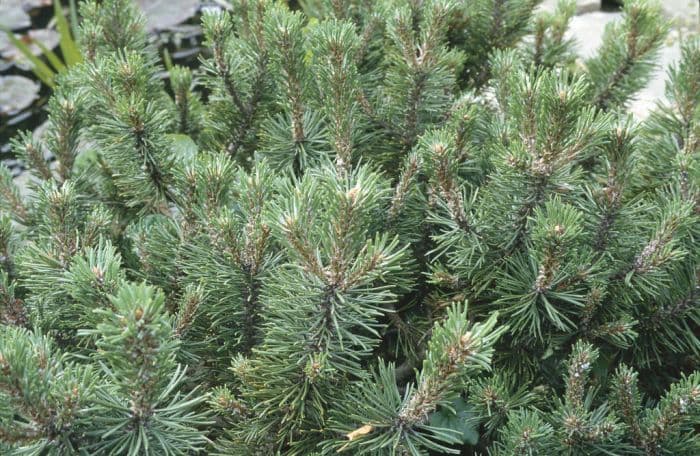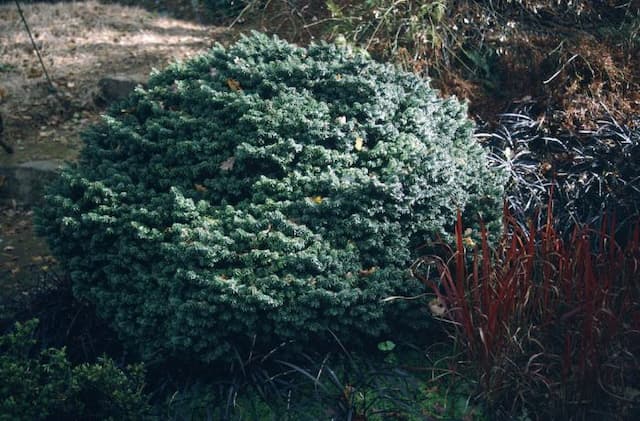Dwarf Mountain Pine Pinus mugo Pumilio Group

ABOUT
The plant known as dwarf mountain pine belongs to the Pumilio Group of Pinus mugo. It is characterized by its dense, rounded and bushy habit that offers a picturesque appearance. This evergreen conifer has dark green needles that are arranged in pairs and possess a slightly curved shape, contributing to its lush and vibrant texture. The needles have a stiff and robust feel, which are well-suited to its mountainous origins. Throughout the year, the plant maintains its color, making it a constant in the garden landscape. In terms of its reproductive features, the dwarf mountain pine produces cones that are small and oval, starting out in a youthful green shade and maturing to a woody brown color. These cones add a decorative element to the plant, particularly when contrasted against the dense backdrop of the needles. In addition to its visual appeal, the plant is also noted for being hardy and adaptable to a variety of conditions. This resilience makes it a popular choice for gardeners and landscape designers who are looking to create a low-maintenance yet attractive scene. The dwarf mountain pine's rugged appearance is often utilized in rock gardens, as a ground cover, or as an accent in mixed borders, drawing on its compact habit to fit into various garden compositions.
About this plant
 Names
NamesFamily
Pinaceae.
Synonyms
Dwarf Mountain Pine, Mugo Pine, Swiss Mountain Pine, Mountain Pine, Dwarf Mugo Pine.
Common names
Pinus mugo var. pumilio (Haenke) Zenari, Pinus mugo subsp. pumilio (Haenke) Domin, Pinus mugo var. rotundata Regel, Pinus mugo var. mugho.
 Toxicity
ToxicityTo humans
The Pinus mugo Pumilio Group, commonly known as Dwarf Mountain Pine, is generally not considered toxic to humans. There are no significant reports of poisoning or adverse reactions from ingesting or handling this plant. However, it is always advisable to exercise caution and not consume plant parts without proper knowledge, as individual allergies or sensitivities to pine resin or pine needles could potentially cause gastrointestinal discomfort or allergic reactions in some people.
To pets
Dwarf Mountain Pine is not known to be toxic to pets. There is no widespread evidence of toxicity in animals such as dogs and cats from ingesting parts of this plant. However, ingestion of non-food items can potentially cause gastrointestinal upset such as vomiting or diarrhea in pets, so it is wise to discourage them from chewing on or ingesting the plant. If you suspect your pet has consumed a large amount of any plant and is displaying symptoms of distress, it is best to consult a veterinarian.
 Characteristics
CharacteristicsLife cycle
Perennials
Foliage type
Evergreen
Color of leaves
Green
Height
3-5 feet (0.9-1.5 meters)
Spread
3-5 feet (0.9-1.5 meters)
Plant type
Shrub
Hardiness zones
2
Native area
Europe
Benefits
 General Benefits
General Benefits- Landscape aesthetic: The Dwarf Mountain Pine adds visual interest to gardens with its compact, shrubby form and dark green needles.
- Low maintenance: Once established, this plant requires minimal care, making it ideal for busy gardeners or those seeking low-maintenance landscaping.
- Cold tolerance: Adapted to cold climates, it is an excellent choice for gardens in areas with harsh winters.
- Erosion control: Its root system helps stabilize slopes and prevent soil erosion.
- Wildlife habitat: Provides shelter and nesting sites for birds and other wildlife.
- Drought resistance: Once established, it has good tolerance to drought, reducing the need for irrigation.
- Adaptability: It can thrive in a range of soil types, as long as they are well-drained.
- Windbreak: When planted in groups, it can serve as a windbreak, protecting gardens and buildings from strong winds.
- Year-round interest: Being an evergreen, it offers color and texture in the landscape throughout all seasons.
 Medical Properties
Medical Properties- Respiratory support: The essential oils from Dwarf Mountain Pine (Pinus mugo Pumilio Group) have been traditionally used to help with breathing difficulties by acting as an expectorant.
- Anti-inflammatory: Compounds found in Dwarf Mountain Pine may have anti-inflammatory effects which could help reduce inflammation.
- Antiseptic: The essential oil is sometimes used for its antiseptic properties, which can help in preventing the growth of germs.
 Air-purifying Qualities
Air-purifying QualitiesThis plant is not specifically known for air purifying qualities.
 Other Uses
Other Uses- Bonsai Creation: Due to its compact growth habit, the mugo pine is commonly used for bonsai as it can be trained and pruned to create miniature landscapes.
- Windbreaks: In landscapes, mugo pine can serve as a windbreak, reducing wind speed and protecting gardens or structures.
- Soil Stabilization: Its root system helps stabilize soil on slopes and prevent erosion, making it useful in landscape restoration projects.
- Privacy Screening: Mugo pine can be planted as a privacy screen or a living fence, offering year-round concealment due to its dense foliage.
- Topiary Art: The plant can be shaped and maintained in artistic topiary forms, showcasing gardeners' sculpting skills.
- Wildlife Shelter: Provides habitat and shelter for various wildlife including birds, who may use them for nesting or protection.
- Cultural Symbolism: In some cultures, the mugo pine is symbolic and used in traditional ceremonies or as part of festive decorations.
- Photography Subject: Its picturesque quality makes it a popular subject for photographers, especially when its rugged form is covered with snow.
- Educational Tool: Used in schools or environmental programs to teach about coniferous plants and alpine ecosystems.
- Sound Barrier: When placed strategically, mugo pine hedges can help reduce noise pollution in residential and urban areas.
Interesting Facts
 Feng Shui
Feng ShuiDwarf Mountain Pine is not used in Feng Shui practice.
 Zodiac Sign Compitability
Zodiac Sign CompitabilityDwarf Mountain Pine is not used in astrology practice.
 Plant Symbolism
Plant Symbolism- Resilience: The Pumilio Group of Pinus mugo, commonly known as Dwarf Mountain Pine, often grows in challenging alpine climates, symbolizing the ability to thrive amidst adversity.
- Endurance: Dwarf Mountain Pine is known for its longevity and hardiness, representing the quality of enduring through difficult times without succumbing to external pressures.
- Stability: As an evergreen, the Dwarf Mountain Pine symbolizes stability and the constancy of life, remaining green throughout the seasons.
- Protection: The thick branches and foliage of the Dwarf Mountain Pine provide shelter in its natural habitat, symbolizing safety and protection.
 Water
WaterDwarf Mountain Pine should be watered regularly but allow the soil to dry out slightly between waterings to avoid waterlogging. During the growing season, a rough guideline is to water once a week with about 1 to 2 gallons per plant, depending on the size and age of the plant as well as the climate conditions. Reduce frequency during the winter months when the plant is dormant, watering only enough to prevent the soil from completely drying out. Ensure that the plant has good drainage to prevent root rot.
 Light
LightDwarf Mountain Pine thrives in full sun, meaning it requires at least 6 hours of direct sunlight each day. The best spot for this plant would be an open area where it is exposed to unfiltered sunlight for the majority of the day. Avoid planting it in deep shade or heavily filtered light as this can affect its growth and health.
 Temperature
TemperatureDwarf Mountain Pine is hardy and adapts to a wide range of temperatures, but it does best in cooler climates. It can survive in temperatures down to -20 degrees Fahrenheit and is comfortable up to 70 degrees Fahrenheit, although it can endure higher temperatures if necessary. The ideal range for this plant is between 30 and 60 degrees Fahrenheit.
 Pruning
PruningPruning the Dwarf Mountain Pine is typically done to maintain its shape or to remove damaged or diseased branches. Pruning should be done in late winter or early spring before new growth starts. It is recommended to prune sparingly and to cut back to a side branch or bud to avoid leaving stubs.
 Cleaning
CleaningNot needed
 Soil
SoilDwarf Mountain Pine thrives in well-draining, sandy or loamy soil with a pH range of 5.5 to 7.5. To create the best soil mix, combine two parts sand, one part peat, and one part pine bark. This ensures adequate drainage while also retaining some moisture and nutrients.
 Repotting
RepottingDwarf Mountain Pine should be repotted every 2 to 3 years, ideally in the spring. As it is a slow-growing conifer, frequent repotting is not necessary. When repotting, ensure minimal root disturbance and use a fresh soil mix that matches the plant's growing requirements.
 Humidity & Misting
Humidity & MistingDwarf Mountain Pine prefers outdoor conditions with natural humidity and does not require specific humidity levels when grown in its preferred environment. As a mountain species, it is adaptable to various humidity levels and is typically hardy and resilient.
 Suitable locations
Suitable locationsIndoor
Provide good light, cool conditions, and well-draining soil.
Outdoor
Plant in full sun, well-drained soil, and water regularly.
Hardiness zone
2-8 USDA
 Life cycle
Life cycleThe Dwarf Mountain Pine (Pinus mugo Pumilio Group) starts its life cycle with seed germination, which occurs when environmental conditions are favorable, typically in spring or early summer. The seedlings develop into young saplings with a strong taproot and grow their first needles. Over several years, the saplings mature into adult shrubs, which are characterized by their dense, bushy growth habit and dark green, needle-like leaves. These mature pines then produce reproductive structures: male cones release pollen, and female cones develop ovules that get fertilized by the pollen, leading to seed development. Once mature, seeds are dispersed by wind or wildlife, completing the reproductive cycle. Finally, these pines can live for many decades, continuously growing, reproducing, and contributing to the forest ecosystem.
 Propogation
PropogationPropogation time
Late winter
Propogation: The most popular method of propagating the dwarf mountain pine, scientifically known as Pinus mugo 'Pumilio', is through seeds. Propagation by seed typically begins in the fall when seeds are harvested from mature cones. The seeds require a period of cold stratification to mimic winter conditions and break dormancy; this is often done by placing the seeds in a mixture of moist sand and peat, and storing them in the refrigerator for about 2-3 months at temperatures around 33-39°F (1-4°C). After stratification, the seeds can be sown in well-drained containers in late winter or early spring. It is important to provide a consistent temperature of about 68°F (20°C) and plenty of light for germination and healthy seedling growth. Seedlings are usually allowed to grow in their containers for at least one season before being transplanted to a permanent location outdoors.









